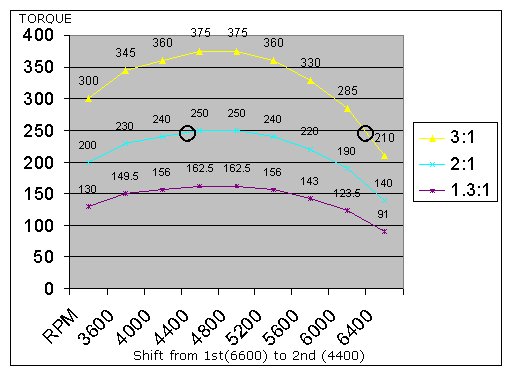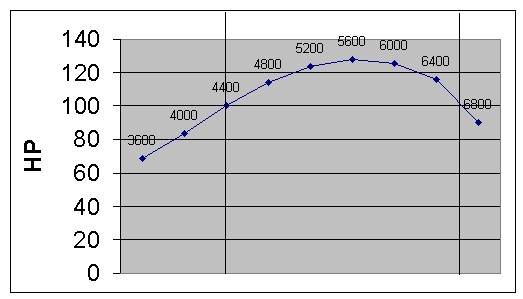SOFTWARE Calculate
your
|
Optimal shift points By Dave Lum - 10/22/98 Looking to get maximum effect out of your car when accelerating? Try optimizing the RPM's you shift your car at. If you're shifting at redline, you're probably not getting the best acceleration out of your car - in fact, the optimum shift RPM will probably be different for each gear. You can calculate the optimum shift points, but it takes two pieces of information : Gear ratios of all your gears, and a chart of your torque curve. If you don't understand torque curves, you may want to take a look at the horsepower article in my Technical Department before reading any farther. The trick here is to keep your engine in the meaty part of the torque curve, as your acceleration curve will match your torque curve - meaning if your torque peak is at 3000rpm, that's the RPM your car accelerates the hardest. How do you keep the engine in the best part of the curve? Shift when you will be at an RPM where the car will make more torque AFTER you shift than in your current gear. This may sound confusing, but I will give some examples to help demonstrate this. Gear ratio is important because you need to know what your RPM's will drop to once you shift. EXAMPLE : If you're at 6500rpm in first, you need the gear ratio to know what RPM that will translates to once you shift to 2nd. Below is a torque curve for a fictitious engine :
Notice anything? The two torque outputs are almost the same (6600 in first and 4400 in second), which is what you're going for to achieve maximum acceleration. What does it look like on the horsepower side? Take a look at the chart below :
Well what do you know! You bracket the HP peak. HP after the shift is the same as HP before the shift. Now we know shifting at the torque peak isn't the answer, and neither is shifting at the HP peak. The math required : next higher gear ratio / current gear ratio (i,e. second gear divided by first) = X X * shiftrpm = nextrpm, where shiftrpm is the point your shifting AT, and nextrpm will be the RPM of the next gear at the same speed. firstgeartorque = torque at shiftrpm times current gear ratio (example, at 6400rpm we have 95ft/lbs, multiply this by our gear ratio in 1st (3:1, or just 3) and you get about 245ft/lbs. secondgeartorque = torque at nextrpm times next gear ratio (in out example, we have 120ft/lbs @ 4400rpm, times 2:1 (second gear ratio), and you get 240ft/lbs. Change shiftrpm until firstgeartorque is equal (or close to) secondgeartorque. |
|||||||||||||||||||||||||||||||||||||||||||||||||||||||||||||

